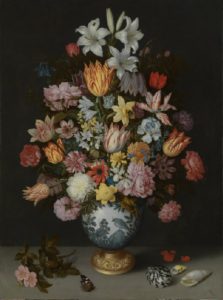 Free at the National Gallery, London, is the current small exhibition of Dutch paintings of flowers. Timed to coincide with this year’s Flower Shows at Hampton Court and Chelsea you can find it in Room 1 on the left at the top of the entrance hall stairs. It is worth a visit, just to see the remarkable detail up close.
Free at the National Gallery, London, is the current small exhibition of Dutch paintings of flowers. Timed to coincide with this year’s Flower Shows at Hampton Court and Chelsea you can find it in Room 1 on the left at the top of the entrance hall stairs. It is worth a visit, just to see the remarkable detail up close.
The Dutch began the trend of flower painting in the early 17th century, coinciding with the rise of Dutch mercantile fortunes and the Dutch East and West India Companies. The art blossomed to its peak in the late 18th century. Many of the subjects of these beautiful paintings are the treasures brought back from wide-ranging voyages of discovery and exploration, not to say exploitation, as well as the taming and changing of nature as the science of botany was exploited in ever more lucrative ways.
Tulips were first introduced to the Netherlands from Turkey in the early 17th century and quickly became highly prized, their blooms changing year on year from plain to vividly striped, without warning. We now know that a virus in the plant forms these 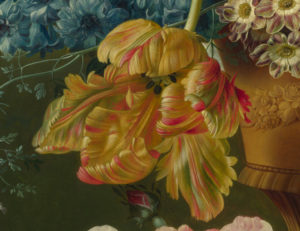 variegations, but at the time they appeared wondrous. Exotic varieties were much sought after and changed changes for increasingly high sums. This resulted in ‘tulipmania’ in the 1630s, until the bottom dropped out of the market in 1637. The flower paintings show many of the most popular varieties. Deborah Moggach wrote a novel about it all – Tulip Fever.
variegations, but at the time they appeared wondrous. Exotic varieties were much sought after and changed changes for increasingly high sums. This resulted in ‘tulipmania’ in the 1630s, until the bottom dropped out of the market in 1637. The flower paintings show many of the most popular varieties. Deborah Moggach wrote a novel about it all – Tulip Fever.
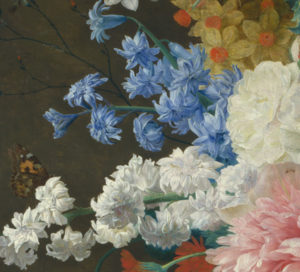 Their popularity was surpassed, however, when plant breeders began to develop new strains of hyacinth. Hyacinths have always grown wild in the near east, but the Dutch it was who cross-bred them to produce ever larger, double blooms with stronger perfume. More and more colours were bred and there was a less well-known, because short-lived, ‘hyacinthmania’ during the 1730s. By the end of the century over two thousand varieties were being cultivated, mostly in the fields around Haarlem.
Their popularity was surpassed, however, when plant breeders began to develop new strains of hyacinth. Hyacinths have always grown wild in the near east, but the Dutch it was who cross-bred them to produce ever larger, double blooms with stronger perfume. More and more colours were bred and there was a less well-known, because short-lived, ‘hyacinthmania’ during the 1730s. By the end of the century over two thousand varieties were being cultivated, mostly in the fields around Haarlem.
These exquisite paintings don’t just include flowers, native or otherwise. The unusual and the exotic was much prized, so exotic fruits also appear, such as the pineapple. It was in Holland in the 1650s that the Dutch began cultivating them in especially constructed and heated glass house, using seeds from the colony of Surinam. They were very costly to grow, so were a sign of wealth and status. Another example of expensive imported luxuries, this time from China, is 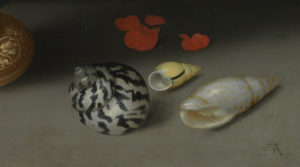 porcelain and several paintings include fine vases of the typical blue and white style subsequently copied so successfully in Dutch ceramics and tile production. As was the possession of curious and unusual seashells, brought back from the Indo-Pacific or Caribbean. ‘Shell mania’ rivalled ‘tulipmania’ for a time, with the ‘shell lunatics’ claiming that at least their collections were permanent, not fading and dying. Look at Bosschaert’s ‘Flowers in a Wan-Li Vase’ for an exquisite depiction of shells.
porcelain and several paintings include fine vases of the typical blue and white style subsequently copied so successfully in Dutch ceramics and tile production. As was the possession of curious and unusual seashells, brought back from the Indo-Pacific or Caribbean. ‘Shell mania’ rivalled ‘tulipmania’ for a time, with the ‘shell lunatics’ claiming that at least their collections were permanent, not fading and dying. Look at Bosschaert’s ‘Flowers in a Wan-Li Vase’ for an exquisite depiction of shells.
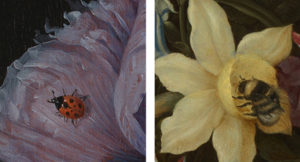 The artists who produced these paintings were sometimes also uprooted – Bosschaert, for example, fled religious persecution in the southern Low Countries. Many of them settled around Haarlem, The Hague and Amsterdam and enjoyed international reputations and high financial reward – Jan van Huysum received the, then extraordinary, sum of 2,000 guilders for one of his paintings. The accuracy in the paintings is remarkable and I especially like the insects, often native to Holland, who seem to have sneaked, unnoticed, into the cornucopia.
The artists who produced these paintings were sometimes also uprooted – Bosschaert, for example, fled religious persecution in the southern Low Countries. Many of them settled around Haarlem, The Hague and Amsterdam and enjoyed international reputations and high financial reward – Jan van Huysum received the, then extraordinary, sum of 2,000 guilders for one of his paintings. The accuracy in the paintings is remarkable and I especially like the insects, often native to Holland, who seem to have sneaked, unnoticed, into the cornucopia.
The exhibition runs until 29th August 2016. If you would like to learn more about the history of this period, the Dutch Golden Age, Simon Schama’s ‘The Embarrassment of Riches‘ is hard to beat for both erudition and readability.
If you enjoyed reading this post you might also enjoy The Painting formerly known as….. Artist & Empire Art


 RSS – Posts
RSS – Posts